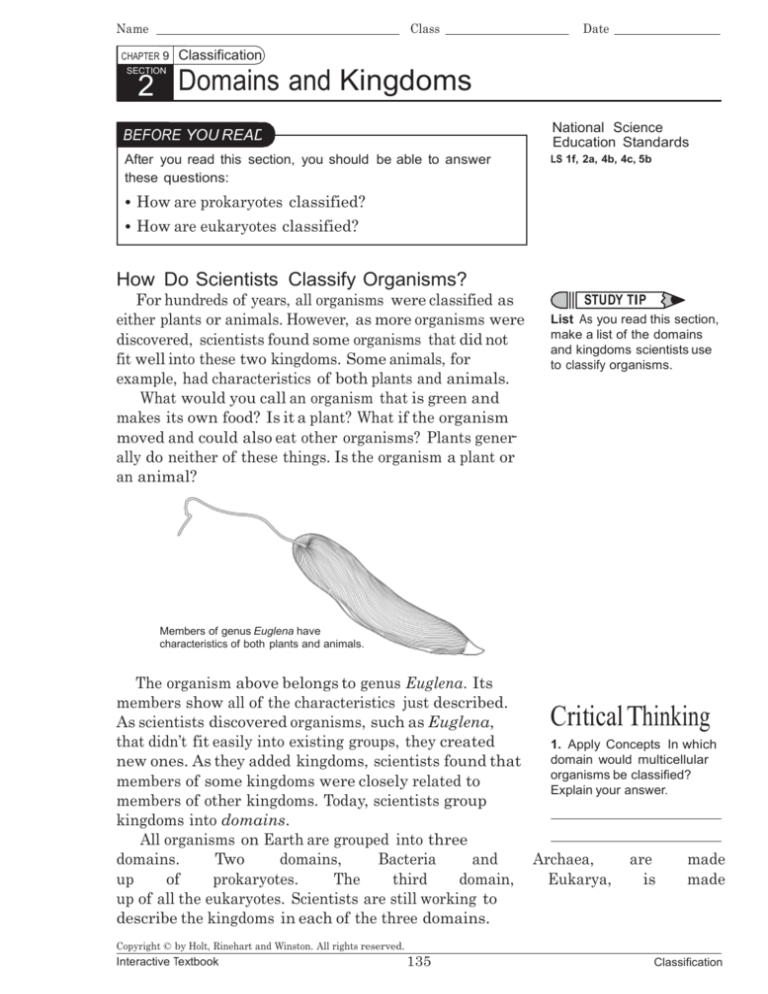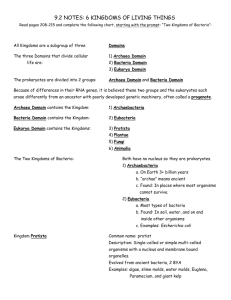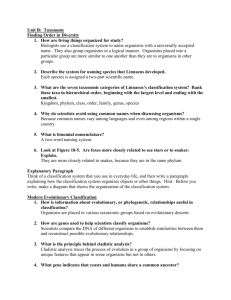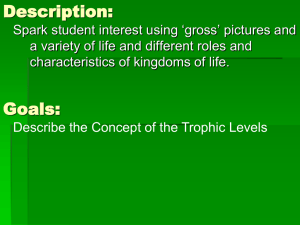
Name
Class
CHAPTER 9
Date
Classification
SECTION
2 Domains and Kingdoms
National Science
Education Standards
BEFORE YOU READ
After you read this section, you should be able to answer
these questions:
LS 1f, 2a, 4b, 4c, 5b
• How are prokaryotes classified?
• How are eukaryotes classified?
How Do Scientists Classify Organisms?
For hundreds of years, all organisms were classified as
either plants or animals. However, as more organisms were
discovered, scientists found some organisms that did not
fit well into these two kingdoms. Some animals, for
example, had characteristics of both plants and animals.
What would you call an organism that is green and
makes its own food? Is it a plant? What if the organism
moved and could also eat other organisms? Plants generally do neither of these things. Is the organism a plant or
an animal?
STUDY TIP
List As you read this section,
make a list of the domains
and kingdoms scientists use
to classify organisms.
Members of genus Euglena have
characteristics of both plants and animals.
The organism above belongs to genus Euglena. Its
members show all of the characteristics just described.
As scientists discovered organisms, such as Euglena,
that didn’t fit easily into existing groups, they created
1. Apply Concepts In which
domain would multicellular
new ones. As they added kingdoms, scientists found that
organisms be classified?
members of some kingdoms were closely related to
Explain your answer.
members of other kingdoms. Today, scientists group
kingdoms into domains.
All organisms on Earth are grouped into three
domains.
Two
domains,
Bacteria
and
Archaea,
are
made
up
of
prokaryotes.
The
third
domain,
Eukarya,
is
made
up of all the eukaryotes. Scientists are still working to
describe the kingdoms in each of the three domains.
Critical Thinking
Copyright © by Holt, Rinehart and Winston. All rights reserved.
Interactive Textbook
135
Classification
Name
SECTION 2
Class
Date
Domains and Kingdoms continued
How Are Prokaryotes Classified?
A prokaryote is a single-celled organism that does not have
a nucleus. Prokaryotes are the oldest group of organisms on
Earth. They make up two domains: Archaea and Bacteria.
DOMAIN ARCHAEA
READING CHECK
2. Compare How are
members of Archaea different
from other prokaryotes?
READING CHECK
3. Explain Are all
bacteria harmful? Explain
your answer.
Domain Archaea is made up of prokaryotes. The cell
walls and cell membranes of archaea are made of different
substances than those of other prokaryotes. Many archaea
can live in extreme environments where other organisms
could not survive. Some archaea can also be found in more
moderate environments, such as the ocean.
DOMAIN BACTERIA
All bacteria belong to domain Bacteria. Bacteria can
be found in the air, in soil, in water, and even on and
inside the human body!
We often think of bacteria as bad, but not all bacteria
are harmful. One kind of bacterium changes milk into
yogurt. Escherichia coli is a bacterium that lives in human
intestines. It helps break down undigested food and produces vitamin K. Some bacteria do cause diseases, such as
pneumonia. However, other bacteria make chemicals that
can help us fight bacteria that cause disease.
TAKE A LOOK
4. Apply Concepts What
kind of prokaryotes do you
think could live in this spring?
Explain your answer.
The Grand Prismatic
Spring in Yellowstone
National Park contains
water that is about 90°C
(190°F). Most organisms
would die in such a hot
environment.
Copyright © by Holt, Rinehart and Winston. All rights reserved.
Interactive Textbook
136
Classification
Name
SECTION 2
Class
Date
Domains and Kingdoms continued
How Are Eukaryotes Classified?
Organisms that have cells with membrane-bound
organelles and a nucleus are called eukaryotes. All
eukaryotes belong to domain Eukarya. Domain Eukarya
includes the following kingdoms: Protista, Fungi, Plantae,
and Animalia.
Protista
Plantae
Fungi
Animalia
STANDARDS CHECK
LS 5a Biological evolution
accounts for the diversity of
species developed through
gradual processes over many
generations. Species acquire
many of their unique
characteristics through biological
adaptation, which involves
the selection of naturally occurring variations in populations.
Biological adaptations include
changes in structures, behaviors,
or physiology that enhance survival and reproductive success in
a particular environment.
Word Help: selection
the process of choosing
This branching diagram shows the
four kingdoms in domain Eukarya.
Word Help: variation
a difference in the form or
function
Domain
Eukarya
KINGDOM PROTISTA
Members of kingdom Protista are either single-celled or
simple multicellular organisms. They are commonly called
protists. Scientists think that the first protists evolved from
ancient bacteria about 2 billion years ago. Much later, plants,
fungi, and animals evolved from ancient protists.
Kingdom Protista contains many different kinds of
organisms. Some, such as Paramecium, resemble animals.
They are called protozoa. Plantlike protists are called
algae. Some algae, such as phytoplankton, are single cells.
Others, such as kelp, are multicellular. Multicellular slime
molds also belong to kingdom Protista.
5. Identify Based on the
branching diagram, which
two kingdoms in Eukarya
evolved most recently?
How do you know?
Paramecium
Copyright © by Holt, Rinehart and Winston. All rights reserved.
Interactive Textbook
137
Classification
Name
SECTION 2
Class
Date
Domains and Kingdoms continued
KINGDOM FUNGI
READING CHECK
Molds and mushrooms are members of kingdom Fungi.
Some fungi (singular, fungus) are unicellular. That is, they are
single-celled organisms. Yeast is unicellular. Most other fungi
are multicellular. Unlike plants, fungi do not perform
photosynthesis. However, they also do not eat food, as
animals do. Instead, fungi use digestive juices to break down
materials in the environment and absorb them.
6. Describe How do fungi
get food?
Amanita is a poisonous fungus. You
should never eat wild fungi.
KINGDOM PLANTAE
Although plants differ in size and appearance, most
people can easily identify the members of kingdom Plantae.
Kingdom Plantae contains organisms that are eukaryotic,
have cell walls, and make food by photosynthesis. Most
plants need sunlight to carry out photosynthesis. Therefore,
plants must live in places where light can reach.
The food that plants make is important for the plants
and also for other organisms. Many animals, fungi, protists,
and bacteria get nutrients from plants. When they digest
the plant material, they get the energy stored by the plant.
Plants also provide homes for other organisms.
Math Focus
7. Calculate The average
student’s arms extend about
1.3 m. How many students
would have to join hands to
form a human chain around
a giant sequoia?
The giant sequoia
is one of the largest
members of kingdom
Plantae. A giant
sequoia can measure
30 m around the
base and grow more
than 91 m tall!
Copyright © by Holt, Rinehart and Winston. All rights reserved.
Interactive Textbook
138
Classification
Name
SECTION 2
Class
Date
Domains and Kingdoms continued
KINGDOM ANIMALIA
Kingdom Animalia contains complex, multicellular
organisms. Organisms in kingdom Animalia are commonly called animals. The following are some characteristics of animals:
• Their cells do not have cell walls.
• They are able to move from place to place.
• They have sense organs that help them react quickly to
their environment.
TAKE A LOOK
8. Identify Which animal
characteristic from above can
be seen in this bald eagle?
STRANGE ORGANISMS
Some organisms are not easy to classify. For example,
some plants can eat other organisms to get nutrition as
animals do. Some protists use photosynthesis as plants
do but also move around as animals do.
Critical Thinking
9. Apply Concepts To get
nutrients, a Venus’ flytrap
uses photosynthesis and
traps and digests insects.
Its cells have cell walls. Into
which kingdom would you
place this organism? Explain
your answer.
Red Cup Sponge
What kind of organism is this red cup sponge? It does
not have sense organs and cannot move for most of its
life. Because of this, scientists once classified sponges as
plants. However, sponges cannot make their own food as
plants do. They must eat other organisms to get nutrients.
Today, scientists classify sponges as animals. Sponges are
usually considered the simplest animals.
Copyright © by Holt, Rinehart and Winston. All rights reserved.
Interactive Textbook
139
Classification
Name
Class
Section 2 Review
Date
NSES
LS 1f, 2a, 4b, 4c, 5b
SECTION VOCABULARY
Animalia a kingdom made up of complex,
multicellular organisms that lack cell walls, can
usually move around, and quickly respond to
their environment
Archaea in a modern taxonomic system, a domain
made up of prokaryotes (most of which are
known to live in extreme environments) that are
distinguished from other prokaryotes by
differences in their genetics and in the makeup
of their cell wall; this domain aligns with the
traditional kingdom Archaebacteria
Bacteria in a modern taxonomic system, a
domain made up of prokaryotes that usually
have a cell wall and that usually reproduce
by cell division. This domain aligns with the
traditional kingdom Eubacteria
Eukarya in a modern taxonomic system, a
domain made up of all eukaryotes; this
domain aligns with the traditional kingdoms
Protista, Fungi, Plantae, and Animalia
Fungi a kingdom made up of nongreen, eukaryotic
organisms that have no means of movement,
reproduce by using spores, and get food by
breaking down substances in their surroundings
and absorbing the nutrients
Plantae a kingdom made up of complex,
multicellular organisms that are usually green,
have cell walls made of cellulose, cannot move
around, and use the sun’s energy to make sugar
by photosynthesis
Protista a kingdom of mostly one-celled eukaryotic
organisms that are different from plants, animals,
bacteria, and fungi
1. Compare What is one major difference between domain Eukarya and domains
Bacteria and Archaea?
2. Explain Why do scientists continue to add new kingdoms to their system of
classification?
3. Analyze Methods Why do you think Linnaeus did not include classifications for
archaea and bacteria?
4. Apply Concepts Based on its characteristics described at the beginning of this sec-
tion, in which kingdom would you classify Euglena?
Life Science
Copyright © by Holt, Rinehart and Winston. All rights reserved.
Interactive Textbook
140
Classification









